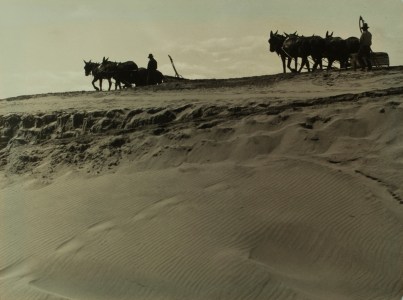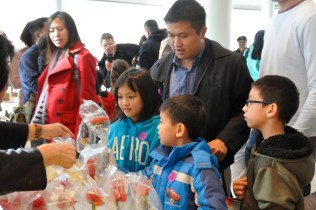In conjunction with Kodomo no Hi—Children’s Day—in Japan, the JANM Collections Unit presented a Members Only Learning at Lunch session on Saturday, May 5. A group of artifacts from the collection, including Boy’s Day Festival in May, was shared with members. The watercolor painting is one of several donated to JANM in 2002 by Charlotte Opler Sagoff. While the other pieces donated at the time are signed and dated by the artist, this painting alone is not, leaving some uncertainty about its origins. It is stylistically similar to a number of the others donated from Sagoff, making its identification as close to positive as our collections team believes to be possible.

Opler further criticized the segregation of “loyal” and “disloyal” internees at Tule Lake, and showed a respect for Japanese culture that went against the mores of the time. Sagoff enrolled their son in the Japanese nursery camp at Tule Lake, making him the only white student. Opler’s willingness to think of the Tule Lake prisoners as real, normal people perhaps stemmed from his ability to situate their culture within a wider worldview. He likened the prisoners’ renewed interest in Japanese traditions to when Plains Indians returned to the Ghost Dance religion, calling both reclamations and affirmations of identities too long sublimated to colonizers. Opler had in fact begun his anthropological career observing Native Americans, alongside his brother Morris, in New Mexico. (While Opler was assigned to Tule Lake, Morris was stationed at Manzanar.)
While at Tule Lake, Opler appreciated the artistic work of those imprisoned. According to Sagoff, he hired artist Dick Toshiki Hamaoka to draw representations of life at Tule Lake because they were unable to afford photographers. Boy’s Day Festival in May, with koinobori in the air, barracks housing, and residents going about their daily lives, is plausibly one such work. According to Sagoff, Hamaoka was 17 at the time he was commissioned and was a cartoonist for his high school newspaper. By her account, after the war, Hamaoka repatriated to Japan.
WRA records indicate that there was a Toshiki D. Hamaoka, a kibei Nisei, from Los Angeles at Tule Lake. However, those records show him to be 25 years of age at the time Sagoff would have known him. Moreover, the WRA shows him as being married, with previous military service, and indicate that he was sent first to Santa Anita and then to the Amache camp (also referred to as the Granada camp) in Colorado. A Bulletin from Granada, Colorado, dated October 21, 1942, corroborates all of this: “Alice Misaye Ouye and Richard Toshiki Hamaoka were married at the Lamar courthouse Thursday. The couple, formerly of Santa Anita, were accompanied by Police Chief Stanley Adams. They now reside at 11G-12F.” The couple was moved to Tule Lake in 1943, perhaps because of responses to the loyalty questionnaire. Final Accountability Records show the Hamaokas arriving at there from Granada in September 1943 and leaving for Japan on Christmas Day 1945. Regardless of his age, WRA records list Hamaoka’s qualified occupation as “artist” and “photographer.”
If Boy’s Day Festival in May is indeed by Hamaoka, it may well be one of his final completed piece before repatriating to Japan.






















 Member Appreciation Days
Member Appreciation Days